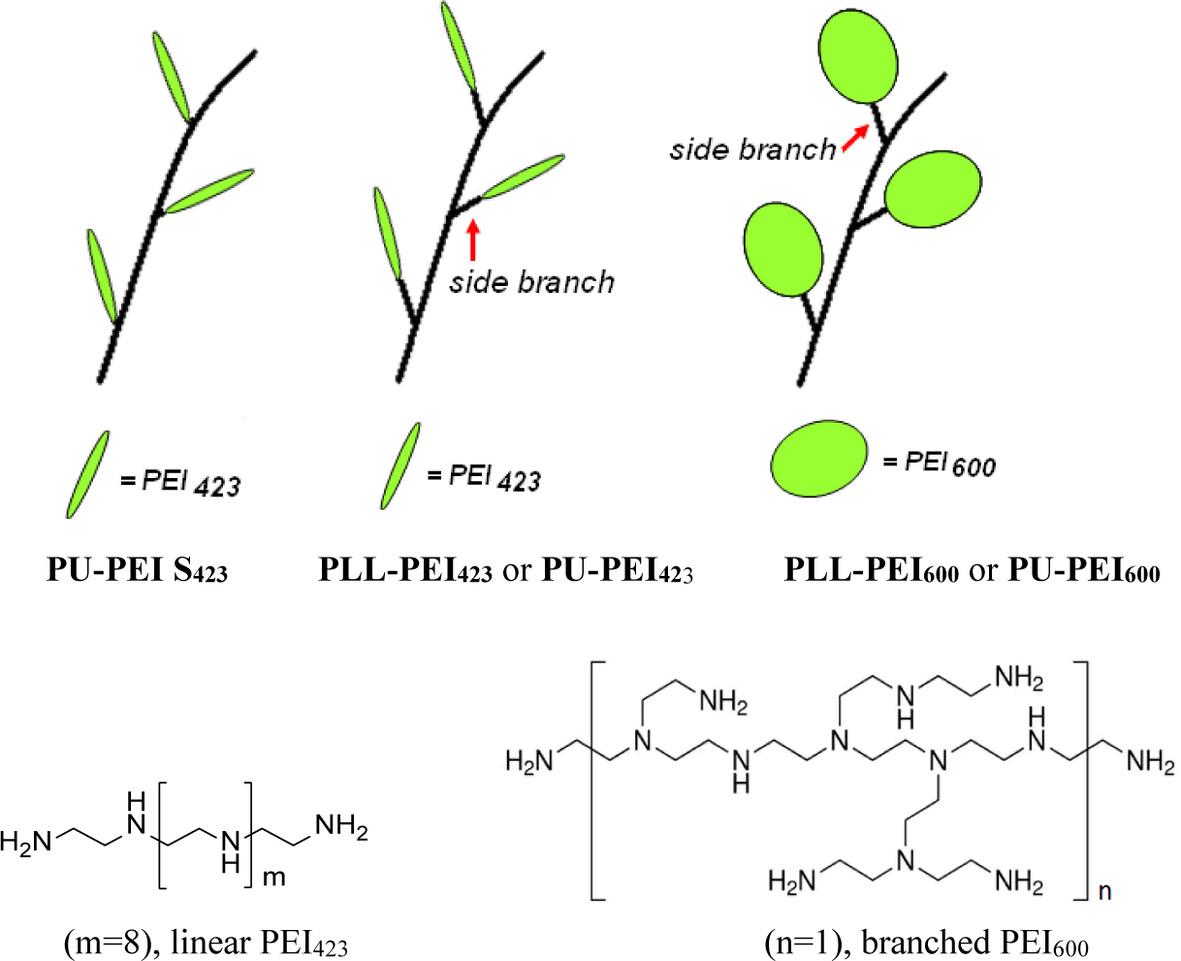求助PDF
{"title":"合成和比较阳离子聚合物的骨架和接枝侧链对其 DNA 转染结构的影响,以实现高效基因递送","authors":"Ting-Yi Hou, Kuang-Hung Pan, Mei-Fen Shih, Jong-Yuh Cherng","doi":"10.1002/pi.6662","DOIUrl":null,"url":null,"abstract":"<p>Many cationic polymers with varied architectures either in backbones or in side chains have been used for gene delivery. However, these polymers yielding different DNA transfection efficiency cannot answer whether backbones or side chains have more influence on DNA delivery. In this research, polyurethanes (PUs) made from the reaction of <span>l</span>-lysine diisocyanate and 1,4-piperazinediethanol were synthesized. Together with poly(<span>l-</span>lysine) (PLL), these polymers were further modified to carry side chains by connecting to low-molecular-weight polyethylenimine (PEI) via imine linkages. The PEI was either linear (423 Da) or branched (600 Da) and grafted to the backbone representing two distinct shapes (i.e. a twig with needle-leaves or round-leaves). In addition, one PU derivative was synthesized to have shorter side chains (as PU-PEI S<sub>423</sub>) than PU-PEI<sub>423</sub> by aminolysis reaction. These synthesized polymers were compared for their transfection potential as gene vectors into cells. Electrophoretic mobility, dynamic light scattering and zeta potential analyses of polymer/DNA complexes confirmed that, after grafting of PEI (PEI<sub>423</sub> or PEI<sub>600</sub>), PLL-PEIs and PU-PEIs were able to self-assemble with plasmid DNA to form nano-scaled (<i>ca</i> 200 nm) and positively charged (<i>ca</i> +25 mV) complexes. These cationic polymers hardly showed any cytotoxicity on COS-7 cells. The outcome of fluorescence imaging and flow cytometry verified that the order of greater transfection efficiency is PLL-PEI<sub>600</sub> = PU-PEI<sub>600</sub> > PLL-PEI<sub>423</sub> = PU-PEI<sub>423</sub> > PEI<sub>25K</sub> (commercial standard) = PU-PEI S<sub>423</sub> >> PLL > PEI<sub>423</sub> = PEI<sub>600</sub> (starting materials). These results reveal that the polymers with longer side chains or higher charge density have positive influence on transfection efficiency. Nevertheless, different polymer backbones may reflect their biodegradability and cytotoxicity, but their effect on transfection efficiency is less significant. © 2024 Society of Chemical Industry.</p>","PeriodicalId":20404,"journal":{"name":"Polymer International","volume":"73 10","pages":"803-814"},"PeriodicalIF":3.6000,"publicationDate":"2024-05-17","publicationTypes":"Journal Article","fieldsOfStudy":null,"isOpenAccess":false,"openAccessPdf":"","citationCount":"0","resultStr":"{\"title\":\"Synthesis and comparison of cationic polymers for structural effects of backbones and grafted side chains on their DNA transfection for efficient gene delivery\",\"authors\":\"Ting-Yi Hou, Kuang-Hung Pan, Mei-Fen Shih, Jong-Yuh Cherng\",\"doi\":\"10.1002/pi.6662\",\"DOIUrl\":null,\"url\":null,\"abstract\":\"<p>Many cationic polymers with varied architectures either in backbones or in side chains have been used for gene delivery. However, these polymers yielding different DNA transfection efficiency cannot answer whether backbones or side chains have more influence on DNA delivery. In this research, polyurethanes (PUs) made from the reaction of <span>l</span>-lysine diisocyanate and 1,4-piperazinediethanol were synthesized. Together with poly(<span>l-</span>lysine) (PLL), these polymers were further modified to carry side chains by connecting to low-molecular-weight polyethylenimine (PEI) via imine linkages. The PEI was either linear (423 Da) or branched (600 Da) and grafted to the backbone representing two distinct shapes (i.e. a twig with needle-leaves or round-leaves). In addition, one PU derivative was synthesized to have shorter side chains (as PU-PEI S<sub>423</sub>) than PU-PEI<sub>423</sub> by aminolysis reaction. These synthesized polymers were compared for their transfection potential as gene vectors into cells. Electrophoretic mobility, dynamic light scattering and zeta potential analyses of polymer/DNA complexes confirmed that, after grafting of PEI (PEI<sub>423</sub> or PEI<sub>600</sub>), PLL-PEIs and PU-PEIs were able to self-assemble with plasmid DNA to form nano-scaled (<i>ca</i> 200 nm) and positively charged (<i>ca</i> +25 mV) complexes. These cationic polymers hardly showed any cytotoxicity on COS-7 cells. The outcome of fluorescence imaging and flow cytometry verified that the order of greater transfection efficiency is PLL-PEI<sub>600</sub> = PU-PEI<sub>600</sub> > PLL-PEI<sub>423</sub> = PU-PEI<sub>423</sub> > PEI<sub>25K</sub> (commercial standard) = PU-PEI S<sub>423</sub> >> PLL > PEI<sub>423</sub> = PEI<sub>600</sub> (starting materials). These results reveal that the polymers with longer side chains or higher charge density have positive influence on transfection efficiency. Nevertheless, different polymer backbones may reflect their biodegradability and cytotoxicity, but their effect on transfection efficiency is less significant. © 2024 Society of Chemical Industry.</p>\",\"PeriodicalId\":20404,\"journal\":{\"name\":\"Polymer International\",\"volume\":\"73 10\",\"pages\":\"803-814\"},\"PeriodicalIF\":3.6000,\"publicationDate\":\"2024-05-17\",\"publicationTypes\":\"Journal Article\",\"fieldsOfStudy\":null,\"isOpenAccess\":false,\"openAccessPdf\":\"\",\"citationCount\":\"0\",\"resultStr\":null,\"platform\":\"Semanticscholar\",\"paperid\":null,\"PeriodicalName\":\"Polymer International\",\"FirstCategoryId\":\"92\",\"ListUrlMain\":\"https://scijournals.onlinelibrary.wiley.com/doi/10.1002/pi.6662\",\"RegionNum\":4,\"RegionCategory\":\"化学\",\"ArticlePicture\":[],\"TitleCN\":null,\"AbstractTextCN\":null,\"PMCID\":null,\"EPubDate\":\"\",\"PubModel\":\"\",\"JCR\":\"Q2\",\"JCRName\":\"POLYMER SCIENCE\",\"Score\":null,\"Total\":0}","platform":"Semanticscholar","paperid":null,"PeriodicalName":"Polymer International","FirstCategoryId":"92","ListUrlMain":"https://scijournals.onlinelibrary.wiley.com/doi/10.1002/pi.6662","RegionNum":4,"RegionCategory":"化学","ArticlePicture":[],"TitleCN":null,"AbstractTextCN":null,"PMCID":null,"EPubDate":"","PubModel":"","JCR":"Q2","JCRName":"POLYMER SCIENCE","Score":null,"Total":0}
引用次数: 0
引用
批量引用



 求助内容:
求助内容: 应助结果提醒方式:
应助结果提醒方式:


